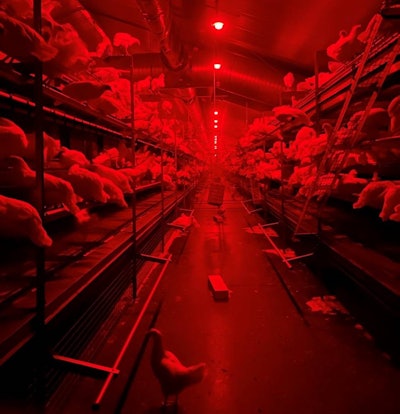
A dynamic lighting system could help commercial egg producers improve layer production and welfare, reduce floor eggs and prevent keel bone damage.
The lighting system, known as NatureDynamics, allows egg producers to formulate lighting recipes, which comprise various combinations dynamic lighting, to optimize each stage of production for layer flocks. Dynamic lighting is defined as a change in the spectrum, intensity and distribution of light over a set schedule of time.
The recipes are designed to encourage birds to lay in the nesting systems, and not in the floor, while improving welfare, explained Dr. Gabrielle House, lighting solutions company Once by Signify Animal Lighting Application Specialist, at 2023 PEAK, a poultry production tradeshow held in in Minneapolis, Minnesota.

“Our lighting system and recipes are able to improve the circadian rhythm of the birds, increase egg production by up to 2% and improve the longevity of laying hens,” she said. “We are able to adjust the light settings using the lighting system’s scheduling and dimming features to maintain the birds’ circadian rhythm over the entire production cycle.”
Because poultry can perceive an ultraviolet portion of the light spectrum that humans cannot, it is important for egg producers to use dynamic lighting as a tool, House explained. The photoreceptors that poultry have in their eyes are important for starting biological processes, such as melatonin cycling. This means the photoreceptors, and the light they are absorbing, are directly related to the circadian rhythm of the birds, which can affect laying hen performance.
One example of a lighting recipe uses enhanced red lighting that simulates the production of neuropeptides in the hypothalamus, which regulates reproduction in laying hens. When a house’s lighting recipe is set to dim to red in the evening, this can increase the circadian experience of the laying hen and reduce stress.
“A dimming light sequence can mimic the sunset and reduce floor eggs because it slowly urges birds to move into the nesting area to sleep instead of sleeping on the floor,” she said. “The slow dimming sequence helps reduce stress in the birds compared to quick changes in light.”
She added that using dimming sequences in the morning and at night prevents birds from being startled, which can help prevent keel bone damage.
Because warm light is favorable to birds compared to cool light, cool light can be used underneath the aviary system to deter floor eggs and warm light can be used to encourage the birds to sleep and lay eggs in the nesting area.


















